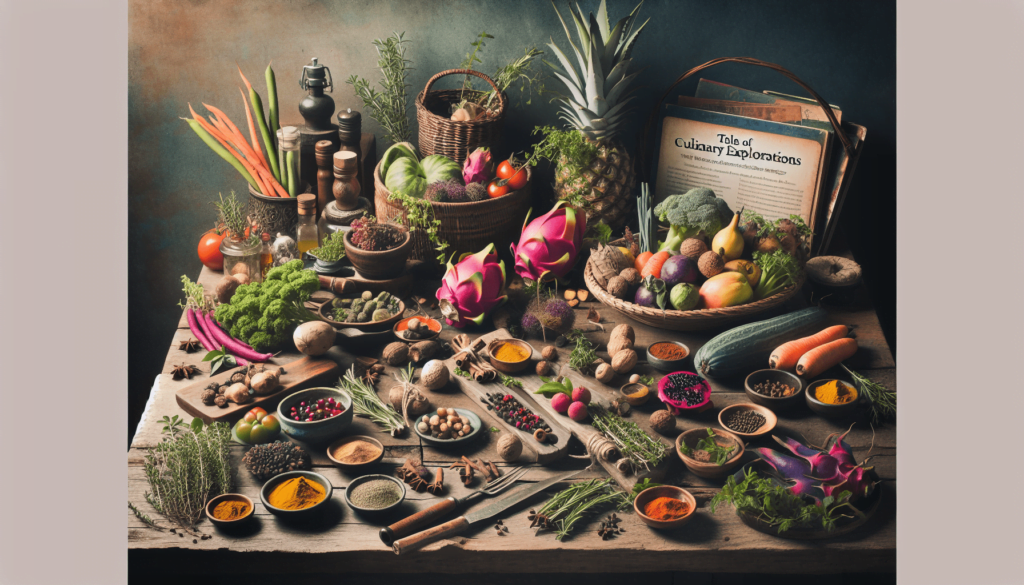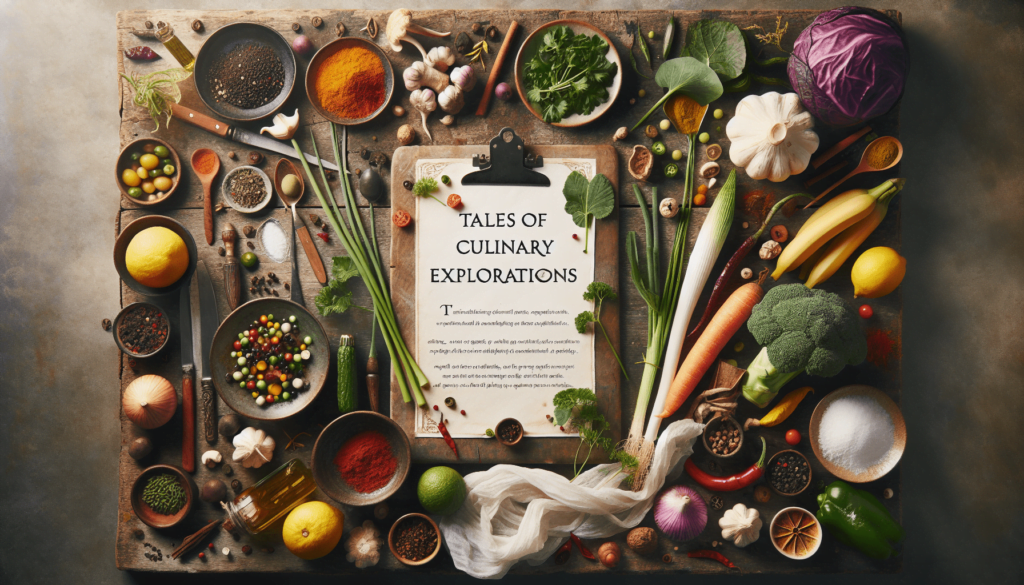Welcome to “Tales of Culinary Explorations,” a delightful journey that takes you through the diverse and vibrant world of global cuisine. Imagine yourself standing at a bustling market in Bangkok, the air thick with the aroma of exotic spices, or strolling through the vineyards of Tuscany, each grape holding secrets from centuries past. You’ll traverse through time and geography, discovering how historical events shaped the kind of foods we cherish today and how modern trends are continually evolving our palates. This article delves into key themes and concepts, from the historical roots of specific dishes to the current trends like farm-to-table and fusion cuisine.
By weaving real-life examples, such as the fascinating case study of sushi’s rise in Western culture, you’ll gain a richer understanding of culinary traditions and their transformations over time. Through comparing various perspectives on these trends, assessing their impacts, and forecasting future culinary directions, you’ll realize the profound societal implications of what we eat. So, grab your fork, and let’s embark on this delectable adventure together!
Have you ever wondered how culinary masterpieces across cultures originate and evolve? Whether you’re a passionate foodie or a casual eater, the stories behind diverse cuisines can ignite the imagination and tantalize the senses. Welcome to “Tales of Culinary Explorations” – where we embark on a flavorful journey through time and across continents to uncover the rich tapestry of culinary traditions.
Table of Contents
Tales of Culinary Explorations
Overview
From the bustling markets of Marrakech to the serene kitchens of Kyoto, every culinary tradition tells a story. These stories are not just about the food itself, but about the culture, history, and people behind it. As globalization brings the world closer together, understanding these tales becomes not just an act of cultural appreciation, but a necessity for anyone looking to truly understand the food they enjoy.
Thesis Statement
In this article, we will delve into the fascinating world of culinary explorations, examining how historical contexts, current trends, and diverse perspectives shape our understanding and appreciation of global cuisines.

Historical Context
To fully appreciate the culinary marvels we enjoy today, it’s essential to understand their origins. Culinary traditions are a window into the past, each bite carrying whispers of history, migration, and cultural exchange.
Ancient Beginnings
For example, take the spice trade. Spices like black pepper, cinnamon, and cloves were once worth their weight in gold. They sparked voyages across unknown seas and prompted the establishment of trade routes between Europe, Asia, and Africa. Driven by a desire for exotic flavors, explorers like Vasco da Gama and Christopher Columbus opened new culinary avenues that profoundly influenced global dietary habits.
The Silk Road
The Silk Road, known more for its role in the exchange of silk, also played a crucial part in culinary history. As traders moved between East and West, they introduced a plethora of ingredients and cooking techniques. Imagine the first time a European chef encountered Chinese noodles or the first instance of Asian traders tasting Mediterranean olive oil – these exchanges forever altered the culinary landscapes of their respective regions.
Current Trends
Fast forward to today, and the culinary world continues to evolve – now at an unprecedented speed. Modern technology and a global mindset have transformed how we approach food.
Farm-to-Table Movement
One of the most significant trends is the farm-to-table movement. This movement focuses on sourcing ingredients directly from local farms to ensure freshness, quality, and sustainability. It’s also an effort to minimize the carbon footprint associated with food transportation. Restaurants and home cooks alike are increasingly emphasizing local, seasonal ingredients, reshaping the way we view and consume food.
Fusion Cuisine
The concept of fusion cuisine – blending elements from different culinary traditions – has moved from novelty to mainstream. Whether it’s Korean tacos or sushi burritos, chefs are breaking culinary boundaries to create dishes that are both innovative and comforting. This trend not only highlights the flexibility and adaptability of cultures but also brings to the fore the creativity inherent in culinary arts.

Key Concepts and Definitions
Before diving deeper, it’s vital to clarify some commonly used terms and concepts in the culinary world.
Umami
A Japanese term meaning “pleasant savory taste,” umami is considered the fifth basic taste, alongside sweet, sour, bitter, and salty. Foods rich in umami include tomatoes, cheese, and soy sauce, and the term underscores the complex layers of flavor that define many traditional dishes.
Terroir
Originally a term from viticulture (wine-making), terroir refers to the unique characteristics imparted by a specific geographical area to the products grown there. When applied to food, it explains why bread from France or coffee from Ethiopia can taste distinctive. Factors such as soil type, climate, and farming methods all contribute to the end product’s unique flavor profile.
Detailed Exploration
Now, let’s delve into some classic practices and modern-day applications that encapsulate the rich narrative of global cuisines.
Exploration Through Case Studies
One of the most effective ways to understand the depth and breadth of culinary explorations is through case studies. These examples illuminate how historical context and modern trends converge to create the rich tapestry of global food culture.
Example 1: The Rise of Italian Cuisine
The global appeal of Italian cuisine is undeniable, but its history reveals a story of adaptation and influence. Initially, Italian cuisine was heavily regional, with each area boasting its own specialties. The introduction of tomatoes from the New World in the 16th century revolutionized Italian cooking, birthing iconic dishes like pasta al pomodoro and Margherita pizza. In modern times, Italian cuisine has embraced trends like farm-to-table, enhancing its traditional preparations with fresh, local ingredients. The enduring popularity of Italian cuisine exemplifies how culinary traditions can adapt over time while retaining their fundamental characteristics.
Example 2: The Evolution of Sushi
Sushi, a staple of Japanese cuisine, provides a perfect lens through which to view culinary evolution. Originally, sushi began as a method of preserving fish in fermented rice. Over centuries, it evolved into the nigiri and sashimi forms we recognize today, thanks largely to the Edo period’s advancements in rice fermentation techniques. With globalization, sushi has undergone further transformations, giving rise to contemporary versions like sushi rolls filled with avocado or cream cheese – ingredients that would be unthinkable in traditional sushi but are now common in Western iterations. The journey of sushi highlights the dynamic interplay between preserving tradition and embracing innovation.
Comparison of Different Perspectives
Culinary traditions vary greatly from culture to culture, affected by geography, climate, religion, and social customs. Understanding these diverse perspectives can enrich our appreciation and enjoyment of different cuisines.
The Western Approach
In Western cultures, meal structure often follows a specific pattern: a starter, main course, and dessert, with a focus on protein-centric dishes. Ingredients like dairy, meat, and refined grains are staples in Western culinary traditions, emphasizing richness and indulgence.
The Eastern Perspective
Eastern culinary traditions often prioritize balance and harmony. The concept of yin and yang in Chinese cooking, for example, emphasizes the balance between hot and cold, spicy and mild dishes. Rice and noodles are staple carbohydrates, while fish, tofu, and a variety of vegetables are commonly used protein sources.
Impact Assessment
Understanding these divergent approaches helps us appreciate the diversity of global cuisines. The Western focus on richness contrasts with the Eastern emphasis on balance, offering varied gastronomic experiences that cater to different tastes and dietary preferences. This diversity also fosters culinary innovation, as chefs draw inspiration from multiple traditions to create new, hybrid dishes.
Future Directions and Implications
As we look towards the future, several trends and developments are poised to shape the culinary world.
Predictions
Sustainable Eating
Increasingly, the conversation around food is shifting towards sustainability. With concerns about climate change and finite resources, expect to see more plant-based diets and eco-friendly packaging become mainstream. Innovations in lab-grown meat and vertical farming are likely to transform how we source and consume food, making sustainability a key factor in culinary evolution.
Technological Integration
The intersection of technology and food is another exciting frontier. From AI-powered cooking assistants to smart kitchen appliances, technology will continue to revolutionize how we prepare and enjoy meals. Augmented reality (AR) and virtual reality (VR) could offer immersive culinary experiences, such as virtual cooking classes or interactive, 3D food presentations.
Implications
The implications of these trends are profound, affecting not just the food industry but also society at large. Sustainable eating practices can lead to a significant reduction in our ecological footprint, while technological advancements can democratize access to high-quality culinary education and experiences.
Conclusion
Recap
In this exploration of culinary tales, we’ve journeyed through time and across continents. We’ve seen how historical trade routes like the Silk Road enriched kitchens worldwide, how modern trends like farm-to-table and fusion cuisine redefine our food experiences, and how key concepts like umami and terroir add layers of complexity to our culinary understanding. Through detailed case studies of Italian cuisine and sushi, we’ve observed the delicate dance between tradition and innovation.
Final Thought
The culinary world is vast and infinitely fascinating. Next time you savor a dish, think about the rich history, cultural exchange, and innovation that brought it to your table. Perhaps, then, you’ll appreciate not just the flavors but also the stories woven into each bite.
Engage with us! Share your culinary experiences, ask questions, or explore more about global cuisines. Your journey through the tales of culinary explorations is just beginning.
Credible Sources
- Davidson, Alan. “The Oxford Companion to Food.” Oxford University Press, 1999.
- Goldstein, Darra. “The Gastronomica Reader.” University of California Press, 2012.
- Pollan, Michael. “The Omnivore’s Dilemma: A Natural History of Four Meals.” Penguin Press, 2006.
- McGee, Harold. “On Food and Cooking: The Science and Lore of the Kitchen.” Scribner, 2004.
- Albala, Ken. “Food in World History.” Routledge, 2006.
Related site – Rangamati’s culinary canvas: Where simplicity meets sophistication
Palate Passport: A Culinary Journey Around the World
